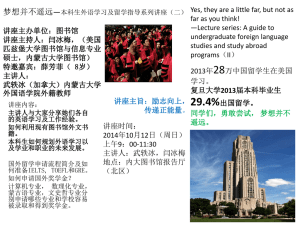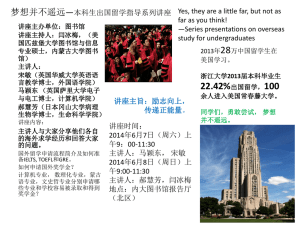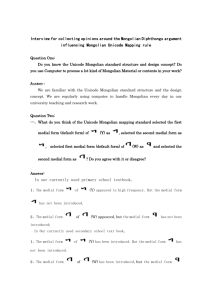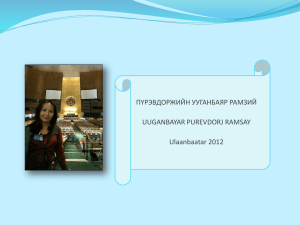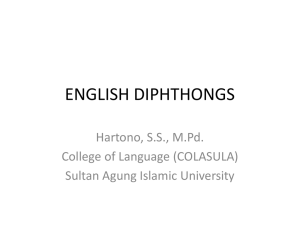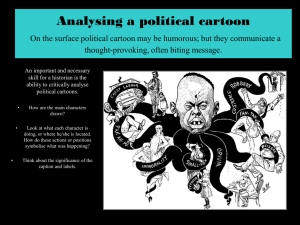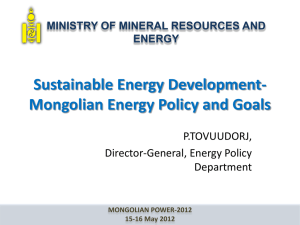ᠮᠤᠩᠭᠤᠯ ᠵᠦᠪ ᠪᠢᠴᠢᠯᠭᠡ ᠶᠢᠨ ᠲᠤᠯᠢ
advertisement
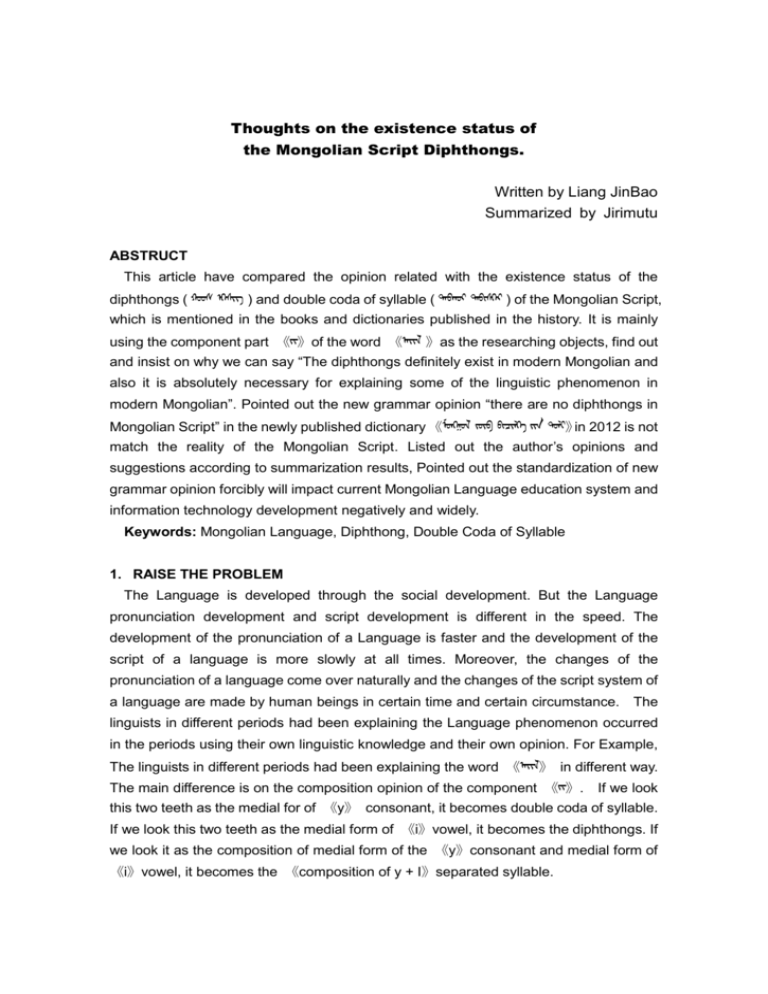
Thoughts on the existence status of the Mongolian Script Diphthongs. Written by Liang JinBao Summarized by Jirimutu ABSTRUCT This article have compared the opinion related with the existence status of the diphthongs ( ᠬᠤᠤᠰ ᠡᠭᠡᠰᠢᠭ ) and double coda of syllable ( ᠳᠠᠪᠬᠤᠷ ᠳᠡᠪᠢᠰᠭᠡᠷ ) of the Mongolian Script, which is mentioned in the books and dictionaries published in the history. It is mainly using the component part 《ᠢᠢ》of the word 《ᠠᠢᠯ 》as the researching objects, find out and insist on why we can say “The diphthongs definitely exist in modern Mongolian and also it is absolutely necessary for explaining some of the linguistic phenomenon in modern Mongolian”. Pointed out the new grammar opinion “there are no diphthongs in Mongolian Script” in the newly published dictionary 《ᠮᠤᠩᠭᠤᠯ ᠵᠦᠪ ᠪᠢᠴᠢᠯᠭᠡ ᠶᠢᠨ ᠲᠤᠯᠢ》in 2012 is not match the reality of the Mongolian Script. Listed out the author’s opinions and suggestions according to summarization results, Pointed out the standardization of new grammar opinion forcibly will impact current Mongolian Language education system and information technology development negatively and widely. Keywords: Mongolian Language, Diphthong, Double Coda of Syllable 1. RAISE THE PROBLEM The Language is developed through the social development. But the Language pronunciation development and script development is different in the speed. The development of the pronunciation of a Language is faster and the development of the script of a language is more slowly at all times. Moreover, the changes of the pronunciation of a language come over naturally and the changes of the script system of a language are made by human beings in certain time and certain circumstance. The linguists in different periods had been explaining the Language phenomenon occurred in the periods using their own linguistic knowledge and their own opinion. For Example, The linguists in different periods had been explaining the word 《ᠠᠢᠯ》 in different way. The main difference is on the composition opinion of the component 《ᠢᠢ》. If we look this two teeth as the medial for of 《y》 consonant, it becomes double coda of syllable. If we look this two teeth as the medial form of 《i》vowel, it becomes the diphthongs. If we look it as the composition of medial form of the 《y》consonant and medial form of 《i》vowel, it becomes the 《composition of y + I》separated syllable. ① The opinion which look it as double coda of syllable 《ᠠᠢᠯ》= A + Y + L, the representative works are ᠳᠠᠨᠵᠠᠨᠳᠠᠭᠪᠠ ᠶᠢᠨ《ᠤᠭᠲᠠᠷᠭᠤᠢ ᠶᠢᠨ beginning of the 18th century) , ᠠᠭᠸᠠᠨᠳᠠᠳᠠᠷ ᠤᠨ《ᠬᠡᠯᠡᠨ ᠤ ᠮᠠᠨᠢ》 (at the ᠴᠢᠮᠡᠭ》 (1828). ② The opinion which look it as diphthongs 《ᠠᠢᠯ》= A + I + L, the representative works are ᠯᠤᠪᠰᠠᠩᠸᠠᠩᠳᠠᠨ ᠤ 《ᠮᠤᠩᠭᠤᠯ ᠬᠡᠯᠡᠨ ᠤ ᠵᠦᠢ》(1951) etc. ③ The opinion which look it as y + I, the opinion no diphthongs 《ᠠᠢᠯ》= A + Y + I + L, the representative works are ᠤᠳᠤ ᠦᠶᠡ ᠶᠢᠨ ᠮᠤᠩᠭᠤᠯ ᠬᠡᠯᠡᠨ ᠤ《ᠮᠤᠩᠭᠤᠯ ᠵᠦᠪ ᠪᠢᠴᠢᠯᠭᠡ ᠶᠢᠨ ᠲᠤᠯᠢ》(2012) etc. We can see that the same word have been analyzed or explained as different composition component in the different periods of time in the history. It is the representative linguistic phenomenon related with the selected word 《ᠠᠢᠯ》. All of these opinion is comes from the representative linguistic works in the history. We cannot easily say which is correct and which is incorrect. But if we study the reasons of these opinions, I think we can summarize it into following two cases. A) The word composition changed in different periods of time in the history, but the word’s actual writing form was not changed even after the composition changed. B) The word composition not changed in different periods of time in the history. The recognition of the word composition structure was changed in different periods of time in the history. Let me use the available related books to analyze the word composition. 2. THE RELATED BOOKS ….. The direct translation omitted. he listed all of the his reference books and the opinion how to decompose the word 《ᠠᠢᠯ》. (1) The opinion which look it as double coda of syllable ① ᠳᠠᠨᠵᠠᠨᠳᠠᠭᠪᠠ ᠶᠢᠨ 《ᠵᠢᠷᠦᠬᠡᠨ ᠤ ᠳᠤᠯᠳᠤ ᠶᠢᠨ ᠲᠠᠢᠯᠪᠦᠷᠢ ᠤᠭᠲᠠᠷᠭᠤᠢ ᠶᠢᠨ ᠮᠠᠨᠢ ᠬᠡᠮᠡᠬᠦ ᠰᠤᠳᠤᠷ ᠣᠷᠤᠰᠢᠪᠠᠢ》 (at the beginning of the 18th century) , ② ③ ④ ⑤ ⑥ ⑦ ᠠᠭᠸᠠᠨᠳᠠᠳᠠᠷ ᠤᠨ《ᠮᠤᠩᠭᠤᠯ ᠦᠰᠦᠭ ᠤᠨ ᠶᠤᠰᠤᠨ ᠢ ᠰᠠᠢᠳᠤᠷ ᠨᠤᠮᠯᠠᠭᠰᠠᠨ ᠬᠡᠯᠡᠨ ᠤ ᠴᠢᠮᠡᠭ ᠬᠡᠮᠡᠭᠳᠡᠬᠦ ᠣᠷᠤᠰᠢᠪᠠᠢ》 (1828). 《ᠶᠡᠬᠡ ᠮᠤᠩᠭᠤᠯ ᠤᠨ ᠳᠤᠬᠢᠶᠠᠨ ᠤ ᠦᠰᠦᠭ ᠢ ᠦᠯᠢᠭᠡᠷᠯᠡᠨ ᠦᠭᠦᠯᠡᠬᠦ ᠤᠬᠠᠭᠠᠨ ᠤ ᠲᠦᠯᠬᠢᠭᠦᠷ ᠬᠡᠮᠡᠨᠭᠲᠡᠬᠦ ᠣᠷᠤᠰᠢᠪᠠᠢ》 ᡀᠠᠮᠦᠰᠦᠷᠦᠩ ᠤᠨ《ᠮᠤᠩᠭᠤᠯ ᠦᠰᠦᠭ ᠤᠨ ᠶᠤᠰᠤᠨ ᠢ ᠲᠣᠲᠤᠷᠬᠠᠢᠯᠠᠨ ᠭᠠᠷᠭᠠᠭᠰᠠᠨ ᠠᠯᠲᠠᠨ ᠲᠤᠯᠢ ᠬᠡᠮᠡᠭᠳᠡᠬᠦ ᠣᠷᠤᠰᠢᠪᠠᠢ》 (1903). ᠯᠤᠪᠰᠠᠩᠵᠦᠢᠺᠤᠸᠠᠷ ᠤᠨ《ᠮᠤᠩᠭᠤᠯ ᠦᠰᠦᠭ ᠤᠨ ᠭᠤᠤᠯ ᠶᠤᠰᠤᠨ ᠢ ᠲᠣᠲᠤᠳᠬᠠᠭᠴᠢ ᠲᠤᠯᠢ ᠬᠡᠮᠡᠬᠦ ᠪᠢᠴᠢᠭ》 (1927). ᠱᠠᠭᠵᠠ ᠶᠢᠨ《ᠮᠤᠩᠭᠤᠯ ᠪᠢᠴᠢᠭ ᠤᠨ ᠳᠦᠲᠡ ᠵᠠᠮ》. ᠨᠠᠴᠢᠨ ᠤ《ᠦᠰᠦᠭ ᠨᠠᠢᠷᠠᠭᠤᠯᠬᠤ ᠶᠢᠨ ᠢᠯᠡᠳᠭᠡᠯ》 (1903). ⑧ ⑨ ⑩ ᠵᠠᠮᠢᠨᠩ ᠤᠨ《ᠠᠩᠬᠠᠨ ᠰᠤᠷᠬᠤ ᠬᠦᠪᠡᠭᠦᠳ ᠤᠨ ᠤᠶᠤᠨ ᠢ ᠨᠡᠭᠡᠭᠡᠬᠦ ᠲᠣᠲᠤᠷᠬᠠᠢ ᠲᠤᠯᠢ ᠬᠡᠮᠡᠭᠳᠡᠬᠦ ᠣᠷᠤᠰᠢᠪᠠᠢ》 (1927). ᠭᠠᠯᠰᠠᠩ ᠤᠨ《ᠮᠤᠩᠭᠤᠯ ᠦᠰᠦᠭ ᠤᠨ ᠪᠦᠭᠦᠳᠡ ᠲᠠᠢᠯᠪᠦᠷᠢ ᠪᠢᠴᠢᠭ》 (1979). ᠴᠤᠢᠵᠤᠩᠵᠠᠪ ᠪᠠᠭᠰᠢ ᠶᠢᠨ ᠦᠭᠦᠯᠡᠯ《ᠮᠤᠩᠭᠤᠯ ᠪᠢᠴᠢᠭ ᠤᠨ ᠬᠡᠯᠡᠨ ᠤ 〈ᠳᠡᠪᠢᠰᠭᠡᠷ ᠦᠰᠦᠭ〉 ᠤᠨ ᠲᠤᠬᠠᠢ ᠪᠤᠳᠤᠯᠬᠢᠯᠠᠯ》 (2009). (2) The opinion which look it as diphthongs ① ᠯᠤᠪᠰᠠᠩᠸᠠᠩᠳᠠᠨ ᠤ 《ᠮᠤᠩᠭᠤᠯ ᠬᠡᠯᠡᠨ ᠤ ᠵᠦᠢ》(1951) ② ᠪᠠᠲᠤᠪᠠᠶᠠᠷ ᠤᠨ 《ᠮᠤᠩᠭᠤᠯ ᠬᠡᠯᠡᠨ ᠤ ᠵᠦᠢ ᠳᠤ ᠰᠤᠷᠬᠤ ᠪᠢᠴᠢᠭ》(1960) ③ 《ᠤᠳᠤ ᠦᠶᠡ ᠶᠢᠨ ᠮᠤᠩᠭᠤᠯ ᠬᠡᠯᠡᠨ》(1964) ④ ᠬᠠᠰᠡᠷᠳᠡᠨᠢ ᠶᠢᠨ 《ᠬᠡᠯᠡᠨ ᠤ ᠦᠨᠳᠦᠲᠰᠦ》(1975) ⑤ ᠪᠦᠬᠡᠵᠢᠷᠭᠠᠯ ᠤᠨ 《ᠵᠦᠪ ᠪᠢᠴᠢᠯᠭᠡ ᠶᠢᠨ ᠲᠤᠰᠠᠯᠠᠮᠵᠢ》(1975) ⑥ ᠴᠡᠩᠭᠡᠯᠲᠡᠢ ᠶᠢᠨ 《ᠤᠳᠤ ᠦᠶᠡ ᠶᠢᠨ ᠮᠤᠩᠭᠤᠯ ᠬᠡᠯᠡᠨ ᠤ ᠵᠦᠢ》(1979) ⑦ ᠪᠤ᠂ ᠪᠤᠯᠠᠭ ᠤᠨ 《ᠮᠤᠩᠭᠤᠯ ᠦᠰᠦᠭ ᠪᠢᠴᠢᠭ ᠤᠨ ᠲᠤᠪᠴᠢ ᠲᠡᠦᠬᠡ》(1983) ⑧ ᠽ ᠂ ᠫᠦᠷᠪᠦ ᠶᠢᠨ 《ᠮᠤᠩᠭᠤᠯ ᠦᠰᠦᠭ ᠪᠢᠴᠢᠭ ᠤᠨ ᠵᠦᠪ ᠪᠢᠴᠢᠬᠦ ᠳᠦᠷᠢᠮ》(1979) ⑨ ᠡᠷᠳᠡᠨᠢᠪᠠᠭᠠᠨᠠ ᠶᠢᠨ《ᠮᠤᠩᠭᠤᠯ ᠬᠡᠯᠡᠨ ᠤ ᠵᠦᠢ》(1978) ⑩ ᠪᠤᠶᠠᠨ ᠂ ᠰᠠᠢᠨ ᠤ《ᠮᠤᠩᠭᠤᠯ ᠬᠡᠯᠡᠨ ᠤ ᠵᠦᠢ ᠶᠢᠨ ᠰᠠᠭᠤᠷᠢᠢ ᠮᠡᠳᠡᠯᠭᠡ ᠶᠢᠨ ᠲᠤᠪᠴᠢ》(1977) ⑪ ᠪᠦᠬᠡᠵᠢᠷᠭᠠᠯ᠂ ᠡᠩᠬᠡ ᠶᠢᠨ《ᠮᠤᠩᠭᠤᠯ ᠬᠡᠯᠡᠨ ᠤ ᠵᠦᠢ》(1977) ⑫ ᠳᠠᠸᠠ ᠶᠢᠨ《ᠤᠷᠴᠢᠨ ᠴᠠᠭ ᠤᠨ ᠮᠤᠩᠭᠤᠯ ᠬᠡᠯᠡᠨ ᠤ ᠰᠠᠭᠤᠷᠢ ᠮᠡᠳᠡᠯᠭᠡ》(1978) ⑬ ᠠᠯᠲᠠᠨᠴᠢᠯᠠᠭᠤ᠂ ᠭᠠᠷᠤᠳᠢ ᠶᠢᠨ《ᠤᠷᠴᠢᠨ ᠴᠠᠭ ᠤᠨ ᠮᠤᠩᠭᠤᠯ ᠬᠡᠯᠡᠨ ᠤ ᠰᠠᠭᠤᠷᠢ ᠮᠡᠳᠡᠯᠭᠡ》(1998) ⑭ ᠭᠠᠷᠤᠳᠢ ᠶᠢᠨ《ᠤᠷᠴᠢᠨ ᠴᠠᠭ ᠤᠨ ᠮᠤᠩᠭᠤᠯ ᠬᠡᠯᠡᠨ》(2001) ⑮ ᠸ᠂ ᠰᠡᠴᠡᠨ ᠤ《ᠮᠤᠩᠭᠤᠯ ᠬᠡᠯᠡᠨ ᠤ ᠦᠨᠳᠦᠰᠡᠦᠨ ᠮᠡᠳᠡᠯᠭᠡ》(2006) ⑯ ᠲᠦᠮᠡᠨᠵᠢᠷᠭᠠᠯ ᠤᠨ《ᠤᠳᠤ ᠦᠶᠡ ᠶᠢᠨ ᠮᠤᠩᠭᠤᠯ ᠬᠡᠯᠡ》(2009) ⑰ ᠪᠠᠭᠰᠢ ᠨᠠᠷ ᠤᠨ《ᠰᠤᠷᠤᠭᠴᠢ ᠶᠢᠨ ᠬᠡᠷᠡᠭᠯᠡᠭᠡᠨ ᠤ ᠮᠤᠩᠭᠤᠯ ᠬᠡᠯᠡᠨ ᠤ ᠵᠦᠢ》(2013) (3) The opinion which look it as y + I, the opinion no diphthongs ① ② ᠤᠳᠤ ᠦᠶᠡ ᠶᠢᠨ ᠮᠤᠩᠭᠤᠯ ᠬᠡᠯᠡᠨ ᠤ 《ᠮᠤᠩᠭᠤᠯ ᠵᠦᠪ ᠪᠢᠴᠢᠯᠭᠡ ᠶᠢᠨ ᠲᠤᠯᠢ》(2012) . ᠸᠯᠠᠳᠢᠮᠢᠷᠽᠤᠸ ᠶᠢᠨ《ᠮᠤᠩᠭᠤᠯ ᠬᠡᠯᠡ ᠪᠠ ᠬᠠᠯᠬᠠ ᠠᠶᠠᠯᠭᠤ ᠶᠢ ᠬᠠᠷᠢᠴᠠᠭᠤᠯᠤᠭᠰᠠᠨ ᠬᠡᠯᠡᠨ ᠤ ᠵᠦᠢ》 (4) The intermediate opinion of existence of diphthongs ① ② ③ ④ ⑤ ⑥ ᠮᠤᠩᠭᠤᠯ ᠤᠯᠤᠰ ᠤᠨ ᠡᠷᠳᠡᠮᠲᠡᠨ ᠪ᠂ᠷᠢᠨᠴᠢᠨ ᠤ 《ᠮᠤᠩᠭᠤᠯ ᠪᠢᠴᠢᠭ ᠤᠨ ᠬᠡᠯᠡᠨ ᠤ ᠵᠦᠢ》(1990) . ᠪᠤᠤᠰᠢᠶᠠᠩ ᠪᠠᠭᠰᠢ ᠶᠢᠨ《ᠮᠤᠩᠭᠤᠯ ᠦᠰᠦᠭ ᠪᠢᠴᠢᠭ ᠤᠨ ᠤᠬᠠᠭᠠᠨ》(1984) ᠨᠠ᠊᠂ᠭᠤᠨᠴᠤᠭᠰᠤᠷᠤᠩ ᠤᠨ《ᠮᠤᠩᠭᠤᠯ ᠪᠢᠴᠢᠭ ᠤᠨ ᠬᠡᠯᠡᠨ ᠤ ᠵᠦᠪ ᠪᠢᠴᠢᠬᠦ ᠶᠤᠰᠤ》(1984) ᠰᠠᠩᠵᠢᠶᠧᠧ ᠶᠢᠨ《ᠮᠤᠩᠭᠤᠯ ᠬᠡᠯᠡᠨ ᠤ ᠬᠠᠷᠢᠴᠠᠭᠤᠯᠤᠭᠰᠠᠨ ᠬᠡᠯᠡ ᠵᠦᠢ》(1959) ᠨ᠂ᠫᠤᠫᠫᠠᠧ ᠶᠢᠨ《ᠮᠤᠩᠭᠤᠯ ᠬᠡᠯᠡᠨ ᠤᠨ ᠬᠠᠷᠢᠴᠠᠭᠤᠯᠤᠭᠰᠠᠨ ᠰᠤᠳᠤᠯᠠᠯ ᠤᠨ ᠤᠳᠤᠷᠢᠳᠭᠠᠯ》(1979) ᠨᠠ᠊᠂ᠭᠤᠨᠴᠤᠭᠰᠤᠷᠤᠩ ᠤᠨ《ᠮᠤᠩᠭᠤᠯ ᠪᠢᠴᠢᠭ ᠤᠨ ᠬᠡᠯᠡᠨ ᠤ ᠵᠦᠪ ᠪᠢᠴᠢᠬᠦ ᠶᠤᠰᠤ》(1984) 3. THE DISCUSSION OF THE IMPACT We have investigated in all of the books , works and articles listed above, we can get understand that the internal structure and the writing form of the word 《ᠠᠢᠯ》was not changed at all actually, but the recognition opinion of the linguists is changed in the different periods of time. But why the word composition linguistic rule which was not attracted people7s attention in the past become so important. It is because the language and script usage is just restricted on the speaking, listening, reading and writing. We had paid our attention on the accuracy of the pronunciation that it is just for speaking with mouth and listening with ears, and paid our attention on the accuracy of the script is for writing by hands and reading by eyes. But today, with the information technology development, there are another new requirement – encoding appeared before us and we have to handle it just like the reading, writing, speaking, and listening. Especially, the current standard encoding is based on the word composition element. The word’s composition method, which is the encoding method in the real word, becomes more important than before. Although there are several different opinion for how to decompose the word 《ᠠᠢᠯ》, we need to discuss the impact of the “no diphthong” opinion mentioned in the dictionary 《ᠮᠤᠩᠭᠤᠯ ᠵᠦᠪ ᠪᠢᠴᠢᠯᠭᠡ ᠶᠢᠨ ᠲᠤᠯᠢ》(2012), which is the largely impacting current Mongolian Language education system, As well as the information technology fields. Let me discuss the impact of the changes in details. ① Removing the diphthongs from Mongolian script will impact the current education system large widely. Since the Mongolian grammar book 《ᠮᠤᠩᠭᠤᠯ ᠬᠡᠯᠡᠨ ᠤ ᠵᠦᠢ》written by Lobsongwangdan published in 1951, almost all of the linguistic books as well as the primary school, secondary school and college and university text books have agreed the grammar opinion that is “The Mongolian script have diphthongs”. We have been using the grammar with diphthongs in our entire society Mongolian Language education for 60 years. Inner Mongolia University professor Quejingzhabu, famous linguists, have written in his article as “In Inner Mongolia, when we learning and mastering the Mongolian grammar knowledge and educating the linguistic professionals and experts, the several white books written by Lobsongwangdan teacher had provided the irreplaceable historical mission”. And he had been continuing to write as “I am feeling very proud and glad on that I had introduced the Lobsongwangdan teacher’s white books into Inner Mongolia and, had done the work hardly in my duty as the one of who attending the he Teacher lecture” to expressed his respect to the teacher and his Mongolian grammar books. All of these respectful linguistic books are agreeing the “Mongolian have diphthongs”. But the opinion “Mongolian have no diphthongs” in the currently published dictionary 《ᠮᠤᠩᠭᠤᠯ ᠵᠦᠪ ᠪᠢᠴᠢᠯᠭᠡ ᠶᠢᠨ ᠲᠤᠯᠢ》is repudiating the opinion “Mongolian have diphthongs” in the books mentioned above. This is not just for changing one or two words, this is the grammar changes actually and will widely impact the Mongolian Language education system. For example, a) We need to popularize the new theory of the grammar in the education system. (skipped the detail translation) b) It will impact and require to the Mongolian Syllable Separation education methodology. (skipped the detail translation) c) This will lead us to redefine the Mongolian connection-vowel (ᠬᠤᠯᠪᠤᠬᠤ ᠡᠭᠡᠰᠢᠭ ) grammar theory. (skipped the detail translation) ② Removing the diphthongs from Mongolian script will impact Information Technology utilization. As I have raised above, the impact of removing diphthongs from Mongolian script is very significant in the Information Technology utilization. Mainly, a) The impact on Mongolian word typing input. (skipped the detail translation, if necessary translate it later) b) Lead the data sorting problem. (skipped the detail translation, if necessary translate it later) c) Lead the data consistency problem (skipped the detail translation, if necessary translate it later) ③ The contradiction list existing in the dictionary 《ᠮᠤᠩᠭᠤᠯ ᠵᠦᠪ ᠪᠢᠴᠢᠯᠭᠡ ᠶᠢᠨ ᠲᠤᠯᠢ》 Although in the preface of the dictionary, the authors have pointed out the new theory of ”Mongolian have no diphthongs exist”, but they are not able to promote the theory into entire dictionary entries and there so many contradiction exist in the dictionary. It seems that they are very hurried on creating the dictionary or there are exist different opinion between the authors. It is very important to need the author’s patient and neat manner and attitude, because this dictionary will be the is the epochal landmark in the Mongolian. It is ok to find one or two word mistake, but we cannot accept the theoretical mistakes exist in the dictionary. Let me list some of them. a) Page 704, in the table of the Mongolian script rule, there only one 《᠊ᠢ᠊》 in medial form and there are no 《᠊ᠢᠢ᠊》form in medial. But in the GB 26226-2010, there are 《᠊ᠢᠢ᠊》form in medial. It is making puzzle on if the 《ᠢ》have or no medial 《᠊ᠢᠢ᠊》form. b) In this dictionary, when they explain the standard pronunciation, there a lot of explanation like “….the I under o it will pronounce ….”, this is confusing us on the theory “Mongolian have no diphthongs”. c) Page 773. “there are some rules to pronounce the doubled vowel as the long vowel in Mongolian ….”, and there are have some explaination of double ii. d) Page 774, there are some standard pronunciation of double or triple vowel … the diphthong ai ……. Even this dictionary is agreeing the diphthong exist in Mongolian and why they want to introduce the “No Diphthong” theory into Mongolain? ④ The problems existing Here I have listed some problems existing in our linguistic fields. These list is my own note of the conversation with some of the linguistic professionals and experts when I write this article. Maybe it is not understandable enough, because of the problem listed here is not summarized clearly. a) There are some opinion that “the Mongolian diphthongs are exist in script and not exist in language”. (The detail translation is ignored) b) The diphthongs of the Mongolian are exists from beginning to now. (The detail translation is ignored) c) The reason why remove the Mongolian diphthongs. I am not able to find the reasonable explanation why we have to remove the Mongolian diphthongs. I have found some explanation like “When we encoding the ancient and modern Mongolian in computer and designing the encoding rules for all of the ancient and modern Mongolian, we met some problems related with how to encode the Mongolian diphthongs.” But I am not able to find out any reasonable explanation yet. If there no urgent requirement, why we hurry to change the existing grammar theory ? (Above is summarized, is not the translation.) d) We have to insist the word composition rule consistently. (The detail translation is ignored) e) The word composition of 《 ᠶᠢᠨ ᠂ ᠶᠢ ᠂ ᠢᠶᠡᠷ ᠂ ᠢᠶᠡᠨ》 (The detail translation is ignored) f) Is there any changes to Mongolian script orthographic ? (The detail translation is ignored) ⑤ The author’s point of view It is impossible to find out which is correct and which is incorrect by researching one word 《ᠠᠢᠯ》, but going through the research, maybe I can get some finding in the Mongolian language phenomenon. I would like share my finding and my opinion on it. Actually, the diphthongs itself is not exist in the Mongolian script before. But with the language development, it is appeared in the Mongolian script and made the Mongolian script’s changes and development. Actually the double coda of the syllables and diphthongs are two different explanation of one phonetic phenomenon. I can summarize them in following list. a) There are no diphthongs exist in Mongolian script in the beginning time, the diphthongs in modern Mongolian are the different explanation of the double coda of syllable in ancient Mongolian script. According to the materials listed in this article, there are no diphthongs and long vowels exist in Mongolian language before 14th century. But there are 《y+i》 form 《᠊ᠢᠢ᠊》 in the Mongolian script, in the period of 14th century to the beginning of the 20th century, the Mongolian diphthongs and long vowels appeared in the Mongolian language and in the Mongolian script the linguists in that time explained this 《᠊ᠢᠢ᠊》in the Mongolian script is the medial 《y》. It is the double coda of syllable theory appeared. Maybe in that time the 《᠊ᠢᠢ᠊》still was the old composition 《y+i》, it is just the linguists explained it as the medial form of《y》. Since the beginning of 20th century, the same form 《᠊ᠢᠢ᠊》have been explained as the medial form of 《i》and the diphthong theory appeared. But maybe the word composition of 《᠊ᠢᠢ᠊》is not changed, still was the old form 《y+i》. Although we are explaining the same word composition 《᠊ᠢᠢ᠊》 which had different explanation in the listed three different period of time, is the medial form 《i》with two long teeth. Maybe after one thousand year later, the linguist in that time will explain it as medial form《a》 vowel with two long teeth. Who can exactly predict that is wrong? b) Even the diphthong theory have its own weak points, we have to remove it, it is better to select double coda of syllable theory is near from us than the 《y+i》 theory. Maybe we will select the 《᠊ᠢᠢ᠊》is the medial form of 《y》 first. c) We have one integrity linguistic theories in Mongolian to explain a lot kinds of phonetic and scripting phenomenon now. It is the achievement and result of the effort provided by that so many linguists, professionals and experts. For example, the medial form of 《i》 is 《᠊ᠢᠢ᠊》and the medial form of 《i》with single tooth 《᠊ᠢ᠊》will be used under consonant. The two teeth form of 《i》is used under vowel 《a》 《e》 《o》 《u》and under《ue》in first syllable of the word. All of these theories are created and standardized under the great effort of the linguists, experts and professionals in the past time. For these reason, we cannot easily remove these standardized theory. It is not match the language development rule. d) If the explanation or opinion have different in the different period of time, we should insist on selecting the most modern one, the most fitting with modern linguistic theory one is to match the modern user’s requirement. e) There are diphthongs exactly exists in Modern Mongolian language and script. Not only exists, but also it is so pretty in the logic actually.
